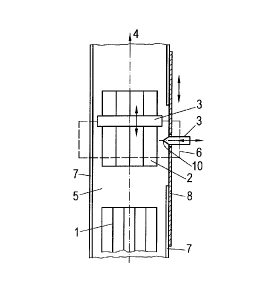Some of the information on this Web page has been provided by external sources. The Government of Canada is not responsible for the accuracy, reliability or currency of the information supplied by external sources. Users wishing to rely upon this information should consult directly with the source of the information. Content provided by external sources is not subject to official languages, privacy and accessibility requirements.
Any discrepancies in the text and image of the Claims and Abstract are due to differing posting times. Text of the Claims and Abstract are posted:
| (12) Patent: | (11) CA 2834316 |
|---|---|
| (54) English Title: | BALE WIRE CUTTER |
| (54) French Title: | DISPOSITIF DE DECOUPAGE DE FIL DE FER DE CERCLAGE |
| Status: | Granted |
| (51) International Patent Classification (IPC): |
|
|---|---|
| (72) Inventors : |
|
| (73) Owners : |
|
| (71) Applicants : |
|
| (74) Agent: | MARKS & CLERK |
| (74) Associate agent: | |
| (45) Issued: | 2019-07-30 |
| (86) PCT Filing Date: | 2012-04-12 |
| (87) Open to Public Inspection: | 2012-11-01 |
| Examination requested: | 2017-02-08 |
| Availability of licence: | N/A |
| (25) Language of filing: | English |
| Patent Cooperation Treaty (PCT): | Yes |
|---|---|
| (86) PCT Filing Number: | PCT/EP2012/056634 |
| (87) International Publication Number: | WO2012/146486 |
| (85) National Entry: | 2013-10-25 |
| (30) Application Priority Data: | ||||||
|---|---|---|---|---|---|---|
|
The invention relates to a device for cutting strappings (1) of cuboid bales (2) by means of at least one cutter bar (3) that can be moved toward the bale (2), wherein the bales (2) are guided along the cutter bar (3) by a conveying apparatus (5) and the cutter bar (3) is arranged on a side of the bales (2) that is directed perpendicularly to the conveying direction (4). Efficient cutting of all strappings (1) is to be made possible by arranging at least two cutter bars (3) on adjoining sides of the bales (2) and by guiding the cutter bars (3) in a traversing device (6) in the conveying direction (4) during the contact with the bales (2).
L'invention concerne un dispositif destiné à découper des cerclages (1) de balles parallélépipédiques (2) au moyen d'au moins une barre porte-lame (3) mobile en direction de la balle (2), les balles (2) étant guidées par un dispositif de transport (5) le long de la barre porte-lame (3) et la barre porte-lame (3) étant disposée sur un côté des balles (2) orienté perpendiculairement au sens du transport (4). L'invention a pour objectif de permettre un découpage efficace de tous les cerclages (1). A cet effet, au moins deux barres porte-lame (3) sont disposées sur des côtés adjacents des balles (2) et les barres porte-lame (3) sont guidées, alors qu'elles sont en contact avec les balles (2), dans un dispositif de traversée (6) dans le sens du transport (4).
Note: Claims are shown in the official language in which they were submitted.
Note: Descriptions are shown in the official language in which they were submitted.

For a clearer understanding of the status of the application/patent presented on this page, the site Disclaimer , as well as the definitions for Patent , Administrative Status , Maintenance Fee and Payment History should be consulted.
| Title | Date |
|---|---|
| Forecasted Issue Date | 2019-07-30 |
| (86) PCT Filing Date | 2012-04-12 |
| (87) PCT Publication Date | 2012-11-01 |
| (85) National Entry | 2013-10-25 |
| Examination Requested | 2017-02-08 |
| (45) Issued | 2019-07-30 |
There is no abandonment history.
Last Payment of $347.00 was received on 2024-04-02
Upcoming maintenance fee amounts
| Description | Date | Amount |
|---|---|---|
| Next Payment if standard fee | 2025-04-14 | $347.00 |
| Next Payment if small entity fee | 2025-04-14 | $125.00 |
Note : If the full payment has not been received on or before the date indicated, a further fee may be required which may be one of the following
Patent fees are adjusted on the 1st of January every year. The amounts above are the current amounts if received by December 31 of the current year.
Please refer to the CIPO
Patent Fees
web page to see all current fee amounts.
| Fee Type | Anniversary Year | Due Date | Amount Paid | Paid Date |
|---|---|---|---|---|
| Application Fee | $400.00 | 2013-10-25 | ||
| Maintenance Fee - Application - New Act | 2 | 2014-04-14 | $100.00 | 2013-10-25 |
| Maintenance Fee - Application - New Act | 3 | 2015-04-13 | $100.00 | 2015-04-01 |
| Maintenance Fee - Application - New Act | 4 | 2016-04-12 | $100.00 | 2016-04-05 |
| Request for Examination | $800.00 | 2017-02-08 | ||
| Maintenance Fee - Application - New Act | 5 | 2017-04-12 | $200.00 | 2017-03-23 |
| Maintenance Fee - Application - New Act | 6 | 2018-04-12 | $200.00 | 2018-03-21 |
| Final Fee | $300.00 | 2019-02-25 | ||
| Maintenance Fee - Application - New Act | 7 | 2019-04-12 | $200.00 | 2019-03-20 |
| Maintenance Fee - Patent - New Act | 8 | 2020-04-14 | $200.00 | 2020-03-30 |
| Maintenance Fee - Patent - New Act | 9 | 2021-04-12 | $204.00 | 2021-03-29 |
| Maintenance Fee - Patent - New Act | 10 | 2022-04-12 | $254.49 | 2022-04-04 |
| Maintenance Fee - Patent - New Act | 11 | 2023-04-12 | $263.14 | 2023-04-03 |
| Maintenance Fee - Patent - New Act | 12 | 2024-04-12 | $347.00 | 2024-04-02 |
Note: Records showing the ownership history in alphabetical order.
| Current Owners on Record |
|---|
| VOITH PATENT GMBH |
| Past Owners on Record |
|---|
| None |